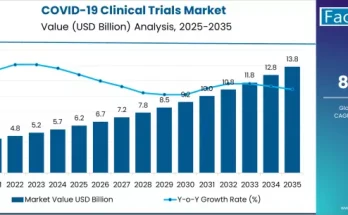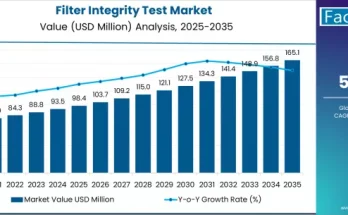The global next-generation pulse oximeters market is projected to experience robust growth, driven by rising demand for advanced, connected patient monitoring and the proliferation of remote healthcare systems. The market is expected to expand from USD 485.0 million in 2025 to approximately USD 1,250.0 million by 2035, representing a compound annual growth rate (CAGR) of 9.9%.
Key Market Highlights
-
2025 Market Size: USD 485.0 million
-
2035 Forecast Value: USD 1,250.0 million
-
Projected CAGR (2025–2035): 9.9%
-
Leading Product Type (2025): Wireless pulse oximeters (approximately 45% share)
-
Primary End‑User Segment (2025): Hospitals (around 50% share)
-
Dominant Technology (2025): Bluetooth‑enabled (about 55% share)
-
Key Regions for Growth: North America, Europe, Asia‑Pacific
-
Major Players: Masimo Corporation, Medtronic plc, Philips Healthcare, Nonin Medical Inc., Smiths Medical, Nihon Kohden, GE Healthcare, Contec Medical Systems, Konica Minolta, Innovo Medical
Market Drivers
-
Increasing Prevalence of Respiratory Diseases
Elevated rates of chronic respiratory conditions, such as COPD and sleep apnea, are driving demand for continuous and accurate oxygen saturation monitoring. -
Growth of Telemedicine & Home Healthcare
The push toward remote patient monitoring is fueling adoption of connected oximeters, especially devices that integrate with telehealth platforms and mobile apps. -
Technological Innovation
Next-generation pulse oximeters are being equipped with AI-enabled algorithms, advanced sensors, and cloud connectivity to deliver smarter, more reliable monitoring. -
Hospitals Increasing Focus on Patient Safety
Hospitals are investing in devices that offer real-time alerts, trend analysis, and integration with electronic health records to improve patient outcomes. -
Rise in Wearable & Mobile Monitoring Devices
As wearables become more common, Bluetooth- and Wi-Fi-enabled oximeters are gaining popularity thanks to their portability, ease of use, and real-time data sharing.
Market Segmentation
-
By Product Type
-
Wireless Pulse Oximeters: Dominant segment, favored for mobility and connectivity.
-
Wearable Pulse Oximeters: Growing in demand due to long-term, continuous monitoring.
-
Traditional Digital Pulse Oximeters: Still relevant but gradually displaced by connected devices.
-
-
By End User
-
Hospitals: Lead in adoption, driven by clinical need for continuous monitoring.
-
Home Healthcare: Rapidly growing with increasing telehealth and post-discharge care.
-
Ambulatory Care & Others: Gaining traction in outpatient settings.
-
-
By Technology
-
Bluetooth-enabled: Most popular, enabling seamless data transfer and device pairing.
-
Wi-Fi-enabled: Offers extended reach and integration with healthcare networks.
-
Non-connected: Basic models still used where connectivity is less critical.
-
-
By Region
-
North America: Leading region due to strong digital health infrastructure.
-
Europe: High adoption of connected devices and compliance-focused healthcare systems.
-
Asia-Pacific: Fastest growth potential with increasing healthcare access and remote monitoring demand.
-
Challenges & Market Risks
-
Regulatory & Accuracy Requirements
Ensuring clinical-grade accuracy while maintaining compliance with medical device regulations can be complex and costly. -
Device Interoperability
Integrating oximeters with existing hospital IT systems and EHRs requires robust connectivity and compatibility. -
Power Consumption & Battery Life
Connected devices must balance performance with battery efficiency, particularly for wearable and mobile units. -
Patient Adoption & Trust
Users may be wary of AI-based or “smart” devices, especially in home settings where reliability and data security matter.
Competitive Landscape
Top manufacturers are focusing on:
-
R&D for AI‑driven analytics, predictive monitoring, and smart alert systems
-
Developing low-power, connected designs with Bluetooth and Wi-Fi
-
Enhancing sensor precision and reducing measurement error
-
Building strong partnerships with healthcare systems, telehealth providers, and medical device distributors
-
Expanding into consumer markets with user-friendly, medical-grade fingertip oximeters
Prominent companies shaping the market include Masimo, Medtronic, Philips, Nonin, Smiths Medical, Nihon Kohden, GE Healthcare, Contec, Konica Minolta, and Innovo Medical.
Strategic Recommendations
-
Expand Remote Monitoring Solutions
Device makers should collaborate with telehealth platforms to develop integrated solutions for remote oxygen saturation tracking. -
Focus on Connectivity and Usability
Enhancing Bluetooth and Wi-Fi features along with app integrations will drive adoption among both clinical and home users. -
Leverage AI and Analytics
Incorporate machine learning to detect trends, generate early warnings, and personalize monitoring parameters for better patient care. -
Strengthen Regulatory Strategy
Ensure compliance with medical device regulation and data privacy laws to facilitate hospital partnerships and market trust. -
Educate Consumers & Clinicians
Launch training and awareness programs about the benefits of next-gen oximeters, especially for chronic disease management and post-discharge care.
Browse Full Report: https://www.factmr.com/report/next-generation-pulse-oximeters-market
Market Outlook
The next-generation pulse oximeters market is poised for transformative growth through 2035. With a projected surge to USD 1.25 billion, the market is being driven by advances in connected healthcare, AI analytics, and continuous remote monitoring. As healthcare systems modernize and digital care becomes more integrated, these devices will become essential tools for both clinical and home settings — offering safer, smarter, and more predictive patient care.


